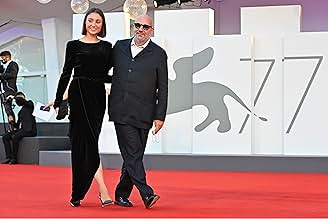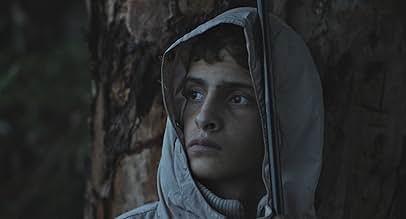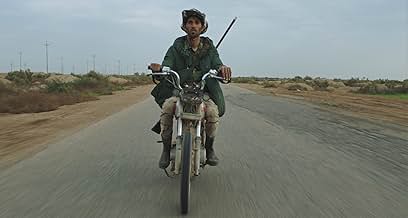NOTE IMDb
6,6/10
1,4 k
MA NOTE
Le nouveau documentaire de Gianfranco Rosi est un portrait immersif des gens qui tentent de survivre dans un Moyen-Orient déchiré par la guerre.Le nouveau documentaire de Gianfranco Rosi est un portrait immersif des gens qui tentent de survivre dans un Moyen-Orient déchiré par la guerre.Le nouveau documentaire de Gianfranco Rosi est un portrait immersif des gens qui tentent de survivre dans un Moyen-Orient déchiré par la guerre.
- Réalisation
- Scénario
- Récompenses
- 7 victoires et 15 nominations au total
Avis à la une
If you aren't blown away by the power of this maybe just stick to Hollywood CGI'd blockbusters. The lack of narration adds power to the heartbreaking stories of ordinary peoples lives in dire situations. If you're expecting to be spoon fed a happy ending just move on this isn't for you, reflection, empathy and questioning the status quo requires intelligence.
Nice images without context. These could have been observed anywhere, with or without a war or other threats around. Did I not have similar problems with Fire At Sea / Fuocoammare at Berlinale 2016?? My first thoughts at the time were that I saw nothing new and revolutionary. Other attendees made me doubt, however. The reactions of people around me forced me to re-think what impact such a documentary can have on the average viewer, apparently on them. What did I miss??
I've seen many documentaries around the same topic in 2016/2017, which causes a certain distance and some feeling that all this should be common knowledge already. Still, images like this seem to impress people. Maybe it showcases the term "impressionistic" I see in many reviews, something that I did not understand when explained at school, and still goes above my head nowadays. Viewers knowledgeable about the context seem able to connect the dots when letting these images pass by. I wonder how it would be received by someone who was not told beforehand what the central topic of conversation was.
Some of the images (1/3 as I mentioned before) can be understood without context, like the women mourning in a prison cell, the soldiers jogging/marching at dawn, soldiers surveying the environment from a shelter, stage players practicing their lines (quoting clear texts about the sorry state of their country), school children explaining their drawings, and so on. Those parts really were memorable. The other 2/3 went past me.
I sat it out through the end, but still do not understand the value of this documentary (if any). Maybe I just don't like kaleidoscopic movies, presenting a series of images/scenes that are not related to each other, not telling a story but merely painting an image where we are pressured to connect the dots and understand what the filmmakers try to convey. It is lost on me, in any case. Another explanation can be that I saw so many documentaries (part of IDFA, Movies That Matter, and other festivals) that are so much more illuminating and compelling, that this one in comparison does very little to pique my interest. It tells nothing new, and just repeats the obvious in a slightly different way but not adding any value. Leaves us with the nice images.
I've seen many documentaries around the same topic in 2016/2017, which causes a certain distance and some feeling that all this should be common knowledge already. Still, images like this seem to impress people. Maybe it showcases the term "impressionistic" I see in many reviews, something that I did not understand when explained at school, and still goes above my head nowadays. Viewers knowledgeable about the context seem able to connect the dots when letting these images pass by. I wonder how it would be received by someone who was not told beforehand what the central topic of conversation was.
Some of the images (1/3 as I mentioned before) can be understood without context, like the women mourning in a prison cell, the soldiers jogging/marching at dawn, soldiers surveying the environment from a shelter, stage players practicing their lines (quoting clear texts about the sorry state of their country), school children explaining their drawings, and so on. Those parts really were memorable. The other 2/3 went past me.
I sat it out through the end, but still do not understand the value of this documentary (if any). Maybe I just don't like kaleidoscopic movies, presenting a series of images/scenes that are not related to each other, not telling a story but merely painting an image where we are pressured to connect the dots and understand what the filmmakers try to convey. It is lost on me, in any case. Another explanation can be that I saw so many documentaries (part of IDFA, Movies That Matter, and other festivals) that are so much more illuminating and compelling, that this one in comparison does very little to pique my interest. It tells nothing new, and just repeats the obvious in a slightly different way but not adding any value. Leaves us with the nice images.
Gianfranco Rosi's "Notturno" (2020) presents itself as a visually striking, yet thematically fragmented documentary that attempts to capture the raw essence of life in the Middle East's war-torn regions. While the film's ambition is admirable, it suffers from several significant flaws that detract from its potential impact.
Firstly, the film's length is a major drawback. At over two hours, "Notturno" feels unnecessarily prolonged, with many scenes stretching beyond their welcome. This extended runtime exacerbates the film's lack of a clear narrative thread. Without a discernible red line connecting the various vignettes, the audience is left to navigate a series of disjointed moments that lack coherence. This absence of a central narrative theme makes the film feel more like a loosely connected collage than a cohesive documentary.
The decision to forgo a musical score further hinders the film. While the absence of music might be intended to emphasize the starkness of the realities depicted, it instead leaves the film feeling monotonous and emotionally flat. Music could have provided a much-needed emotional anchor or rhythm to the film, guiding the viewer through its otherwise repetitive and rhythmically inert sequences.
Speaking of repetition, "Notturno" suffers from a noticeable lack of variation in its shots and scenes. The visual compositions, while often beautiful, become redundant over time. The consistent use of similar framing and pacing contributes to a sense of stagnation, making the film's already slow pace feel even more sluggish.
Moreover, the editing choices leave much to be desired. The film's montage lacks rhythm, and the pacing feels uneven, contributing to a viewing experience that drags rather than engages. The slow, deliberate pacing might be meant to evoke a sense of contemplation, but instead, it often feels ponderous, testing the audience's patience.
Finally, "Notturno" provides little to no context for the scenes it presents. While Rosi's observational style aims to let the images speak for themselves, the lack of explanatory background leaves the viewer grasping for meaning. The film assumes a level of prior knowledge about the region and its conflicts that not all viewers may possess, making it difficult to fully grasp the significance of what is being shown.
In conclusion, while "Notturno" is visually impressive and undoubtedly captures powerful moments, it is weighed down by its excessive length, lack of narrative cohesion, repetitive visuals, and absence of musical or rhythmic structure. The film's minimal context further alienates viewers, leaving them to wade through a disjointed and often tiresome portrayal of life in a conflict zone. Gianfranco Rosi's ambitious vision ultimately falls short, resulting in a documentary that, while occasionally poignant, fails to fully engage or enlighten.
Firstly, the film's length is a major drawback. At over two hours, "Notturno" feels unnecessarily prolonged, with many scenes stretching beyond their welcome. This extended runtime exacerbates the film's lack of a clear narrative thread. Without a discernible red line connecting the various vignettes, the audience is left to navigate a series of disjointed moments that lack coherence. This absence of a central narrative theme makes the film feel more like a loosely connected collage than a cohesive documentary.
The decision to forgo a musical score further hinders the film. While the absence of music might be intended to emphasize the starkness of the realities depicted, it instead leaves the film feeling monotonous and emotionally flat. Music could have provided a much-needed emotional anchor or rhythm to the film, guiding the viewer through its otherwise repetitive and rhythmically inert sequences.
Speaking of repetition, "Notturno" suffers from a noticeable lack of variation in its shots and scenes. The visual compositions, while often beautiful, become redundant over time. The consistent use of similar framing and pacing contributes to a sense of stagnation, making the film's already slow pace feel even more sluggish.
Moreover, the editing choices leave much to be desired. The film's montage lacks rhythm, and the pacing feels uneven, contributing to a viewing experience that drags rather than engages. The slow, deliberate pacing might be meant to evoke a sense of contemplation, but instead, it often feels ponderous, testing the audience's patience.
Finally, "Notturno" provides little to no context for the scenes it presents. While Rosi's observational style aims to let the images speak for themselves, the lack of explanatory background leaves the viewer grasping for meaning. The film assumes a level of prior knowledge about the region and its conflicts that not all viewers may possess, making it difficult to fully grasp the significance of what is being shown.
In conclusion, while "Notturno" is visually impressive and undoubtedly captures powerful moments, it is weighed down by its excessive length, lack of narrative cohesion, repetitive visuals, and absence of musical or rhythmic structure. The film's minimal context further alienates viewers, leaving them to wade through a disjointed and often tiresome portrayal of life in a conflict zone. Gianfranco Rosi's ambitious vision ultimately falls short, resulting in a documentary that, while occasionally poignant, fails to fully engage or enlighten.
Gianfranco Rosi's follow-up to FIRE AT SEA which was about Middle-Eastern and North African migrants coming ashore on a small Italian island. NOTTURNO depicts the circumstances by which many of those refugees come to be. Whether it's Iraq, Kurdistan, Syria or Lebanon Rosi's camera simply captures the lives caught up in the turmoil.
Rosi's Documentary is naturalistic. There is no narration. No title cards. No manipulative music. There's even very little in the way of conversation. Whether it be an all female military troop, a teenage hunter, a group staging a political play, elderly mourners or, most chillingly, a group of school children recounting in words and drawings the horrors of ISIS, Rosi's camera is simply there to record.
The cinematography and sound work is extraordinary, but, they never call undue attention upon themselves. A little familiarity with the wars and political strife that have occurred in the region is helpful. Rosi provides vivid images and audio, but he leaves it to the viewer to provide their own insight. It's a fine achievement.
I don't know Rosi's work as a cameraman, but can imagine some directors like long takes in wide angle, especially when content is not the main thing. So this is documentary 'art' ? Three years of film-making and I see material that's general, could be anywhere, even an LA backwater. Certainly better on a big screen, but watch out if you have a comfortable chair too, as you might sleep and miss most of it.
Le saviez-vous
- AnecdotesOfficial submission of Italy for the 'Best International Feature Film' category of the 93rd Academy Awards in 2021.
- Citations
Teacher: Tell me what you saw.
Meilleurs choix
Connectez-vous pour évaluer et suivre la liste de favoris afin de recevoir des recommandations personnalisées
- How long is Notturno?Alimenté par Alexa
Détails
Box-office
- Montant brut mondial
- 121 053 $US
- Durée1 heure 40 minutes
- Couleur
- Rapport de forme
- 1.85 : 1
Contribuer à cette page
Suggérer une modification ou ajouter du contenu manquant



![Trailer [OV]](https://m.media-amazon.com/images/M/MV5BNzY2YTkyZGQtOWYwOS00MDRhLWEyZDctNWU0MGE2YzdmOGEwXkEyXkFqcGdeQXRyYW5zY29kZS13b3JrZmxvdw@@._V1_QL75_UX500_CR0)


















